Ivana Dusparic
Applying Neural Monte Carlo Tree Search to Unsignalized Multi-intersection Scheduling for Autonomous Vehicles
Oct 24, 2024



Abstract:Dynamic scheduling of access to shared resources by autonomous systems is a challenging problem, characterized as being NP-hard. The complexity of this task leads to a combinatorial explosion of possibilities in highly dynamic systems where arriving requests must be continuously scheduled subject to strong safety and time constraints. An example of such a system is an unsignalized intersection, where automated vehicles' access to potential conflict zones must be dynamically scheduled. In this paper, we apply Neural Monte Carlo Tree Search (NMCTS) to the challenging task of scheduling platoons of vehicles crossing unsignalized intersections. Crucially, we introduce a transformation model that maps successive sequences of potentially conflicting road-space reservation requests from platoons of vehicles into a series of board-game-like problems and use NMCTS to search for solutions representing optimal road-space allocation schedules in the context of past allocations. To optimize search, we incorporate a prioritized re-sampling method with parallel NMCTS (PNMCTS) to improve the quality of training data. To optimize training, a curriculum learning strategy is used to train the agent to schedule progressively more complex boards culminating in overlapping boards that represent busy intersections. In a busy single four-way unsignalized intersection simulation, PNMCTS solved 95\% of unseen scenarios, reducing crossing time by 43\% in light and 52\% in heavy traffic versus first-in, first-out control. In a 3x3 multi-intersection network, the proposed method maintained free-flow in light traffic when all intersections are under control of PNMCTS and outperformed state-of-the-art RL-based traffic-light controllers in average travel time by 74.5\% and total throughput by 16\% in heavy traffic.
Drama: Mamba-Enabled Model-Based Reinforcement Learning Is Sample and Parameter Efficient
Oct 11, 2024



Abstract:Model-based reinforcement learning (RL) offers a solution to the data inefficiency that plagues most model-free RL algorithms. However, learning a robust world model often demands complex and deep architectures, which are expensive to compute and train. Within the world model, dynamics models are particularly crucial for accurate predictions, and various dynamics-model architectures have been explored, each with its own set of challenges. Currently, recurrent neural network (RNN) based world models face issues such as vanishing gradients and difficulty in capturing long-term dependencies effectively. In contrast, use of transformers suffers from the well-known issues of self-attention mechanisms, where both memory and computational complexity scale as $O(n^2)$, with $n$ representing the sequence length. To address these challenges we propose a state space model (SSM) based world model, specifically based on Mamba, that achieves $O(n)$ memory and computational complexity while effectively capturing long-term dependencies and facilitating the use of longer training sequences efficiently. We also introduce a novel sampling method to mitigate the suboptimality caused by an incorrect world model in the early stages of training, combining it with the aforementioned technique to achieve a normalised score comparable to other state-of-the-art model-based RL algorithms using only a 7 million trainable parameter world model. This model is accessible and can be trained on an off-the-shelf laptop. Our code is available at https://github.com/realwenlongwang/drama.git.
Semifactual Explanations for Reinforcement Learning
Sep 09, 2024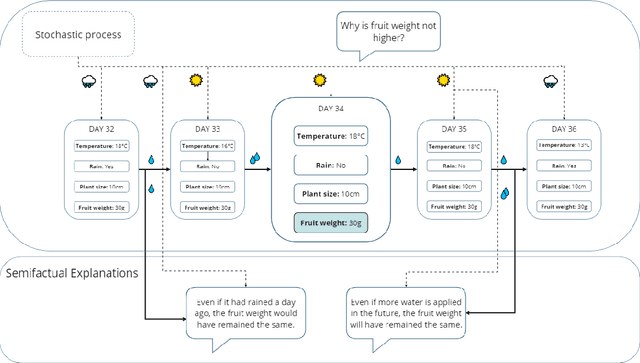


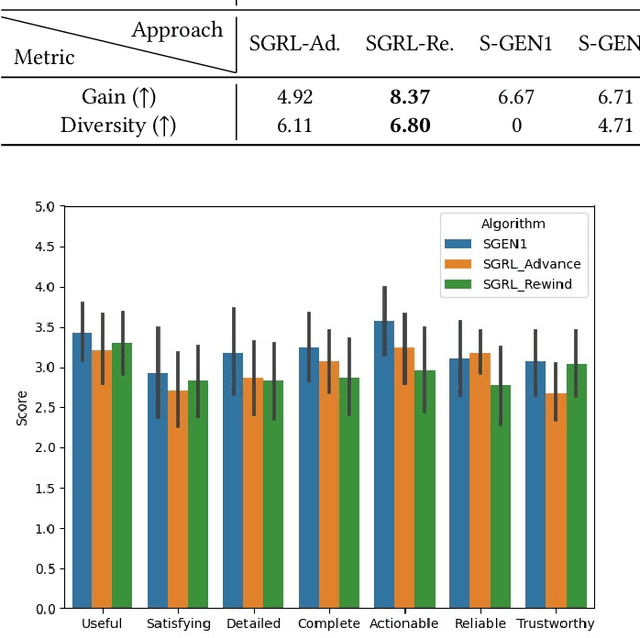
Abstract:Reinforcement Learning (RL) is a learning paradigm in which the agent learns from its environment through trial and error. Deep reinforcement learning (DRL) algorithms represent the agent's policies using neural networks, making their decisions difficult to interpret. Explaining the behaviour of DRL agents is necessary to advance user trust, increase engagement, and facilitate integration with real-life tasks. Semifactual explanations aim to explain an outcome by providing "even if" scenarios, such as "even if the car were moving twice as slowly, it would still have to swerve to avoid crashing". Semifactuals help users understand the effects of different factors on the outcome and support the optimisation of resources. While extensively studied in psychology and even utilised in supervised learning, semifactuals have not been used to explain the decisions of RL systems. In this work, we develop a first approach to generating semifactual explanations for RL agents. We start by defining five properties of desirable semifactual explanations in RL and then introducing SGRL-Rewind and SGRL-Advance, the first algorithms for generating semifactual explanations in RL. We evaluate the algorithms in two standard RL environments and find that they generate semifactuals that are easier to reach, represent the agent's policy better, and are more diverse compared to baselines. Lastly, we conduct and analyse a user study to assess the participant's perception of semifactual explanations of the agent's actions.
ACTER: Diverse and Actionable Counterfactual Sequences for Explaining and Diagnosing RL Policies
Feb 09, 2024Abstract:Understanding how failure occurs and how it can be prevented in reinforcement learning (RL) is necessary to enable debugging, maintain user trust, and develop personalized policies. Counterfactual reasoning has often been used to assign blame and understand failure by searching for the closest possible world in which the failure is avoided. However, current counterfactual state explanations in RL can only explain an outcome using just the current state features and offer no actionable recourse on how a negative outcome could have been prevented. In this work, we propose ACTER (Actionable Counterfactual Sequences for Explaining Reinforcement Learning Outcomes), an algorithm for generating counterfactual sequences that provides actionable advice on how failure can be avoided. ACTER investigates actions leading to a failure and uses the evolutionary algorithm NSGA-II to generate counterfactual sequences of actions that prevent it with minimal changes and high certainty even in stochastic environments. Additionally, ACTER generates a set of multiple diverse counterfactual sequences that enable users to correct failure in the way that best fits their preferences. We also introduce three diversity metrics that can be used for evaluating the diversity of counterfactual sequences. We evaluate ACTER in two RL environments, with both discrete and continuous actions, and show that it can generate actionable and diverse counterfactual sequences. We conduct a user study to explore how explanations generated by ACTER help users identify and correct failure.
Iterative Reward Shaping using Human Feedback for Correcting Reward Misspecification
Aug 30, 2023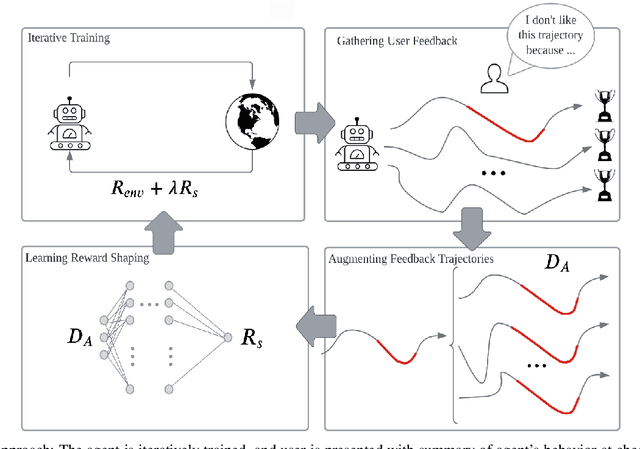

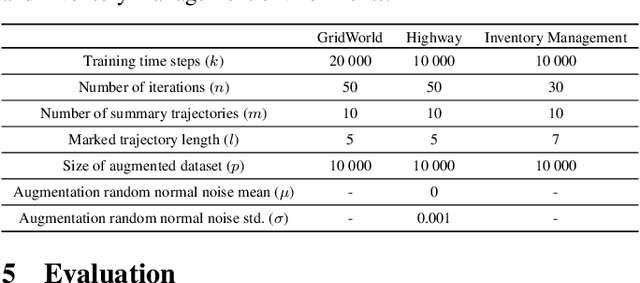

Abstract:A well-defined reward function is crucial for successful training of an reinforcement learning (RL) agent. However, defining a suitable reward function is a notoriously challenging task, especially in complex, multi-objective environments. Developers often have to resort to starting with an initial, potentially misspecified reward function, and iteratively adjusting its parameters, based on observed learned behavior. In this work, we aim to automate this process by proposing ITERS, an iterative reward shaping approach using human feedback for mitigating the effects of a misspecified reward function. Our approach allows the user to provide trajectory-level feedback on agent's behavior during training, which can be integrated as a reward shaping signal in the following training iteration. We also allow the user to provide explanations of their feedback, which are used to augment the feedback and reduce user effort and feedback frequency. We evaluate ITERS in three environments and show that it can successfully correct misspecified reward functions.
Density-Aware Reinforcement Learning to Optimise Energy Efficiency in UAV-Assisted Networks
Jun 14, 2023Abstract:Unmanned aerial vehicles (UAVs) serving as aerial base stations can be deployed to provide wireless connectivity to mobile users, such as vehicles. However, the density of vehicles on roads often varies spatially and temporally primarily due to mobility and traffic situations in a geographical area, making it difficult to provide ubiquitous service. Moreover, as energy-constrained UAVs hover in the sky while serving mobile users, they may be faced with interference from nearby UAV cells or other access points sharing the same frequency band, thereby impacting the system's energy efficiency (EE). Recent multi-agent reinforcement learning (MARL) approaches applied to optimise the users' coverage worked well in reasonably even densities but might not perform as well in uneven users' distribution, i.e., in urban road networks with uneven concentration of vehicles. In this work, we propose a density-aware communication-enabled multi-agent decentralised double deep Q-network (DACEMAD-DDQN) approach that maximises the total system's EE by jointly optimising the trajectory of each UAV, the number of connected users, and the UAVs' energy consumption while keeping track of dense and uneven users' distribution. Our result outperforms state-of-the-art MARL approaches in terms of EE by as much as 65% - 85%.
RACCER: Towards Reachable and Certain Counterfactual Explanations for Reinforcement Learning
Mar 08, 2023Abstract:While reinforcement learning (RL) algorithms have been successfully applied to numerous tasks, their reliance on neural networks makes their behavior difficult to understand and trust. Counterfactual explanations are human-friendly explanations that offer users actionable advice on how to alter the model inputs to achieve the desired output from a black-box system. However, current approaches to generating counterfactuals in RL ignore the stochastic and sequential nature of RL tasks and can produce counterfactuals which are difficult to obtain or do not deliver the desired outcome. In this work, we propose RACCER, the first RL-specific approach to generating counterfactual explanations for the behaviour of RL agents. We first propose and implement a set of RL-specific counterfactual properties that ensure easily reachable counterfactuals with highly-probable desired outcomes. We use a heuristic tree search of agent's execution trajectories to find the most suitable counterfactuals based on the defined properties. We evaluate RACCER in two tasks as well as conduct a user study to show that RL-specific counterfactuals help users better understand agent's behavior compared to the current state-of-the-art approaches.
Expert-Free Online Transfer Learning in Multi-Agent Reinforcement Learning
Mar 02, 2023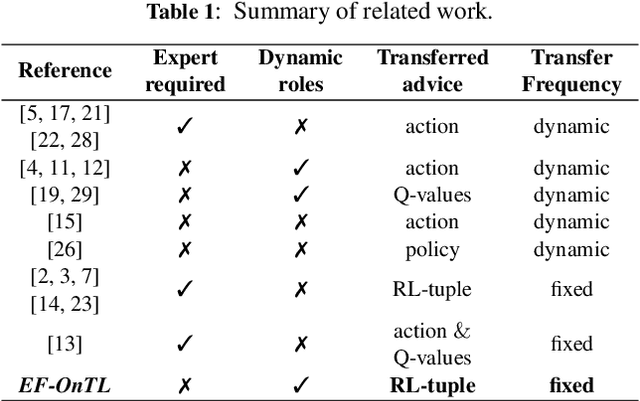
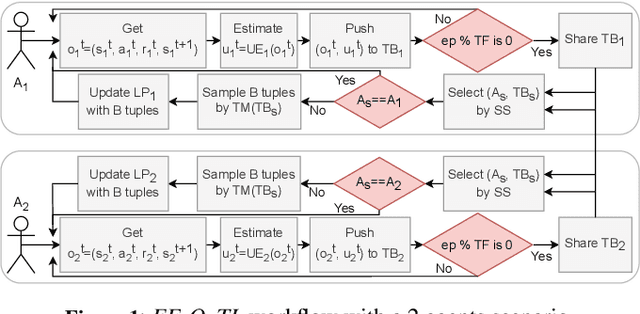
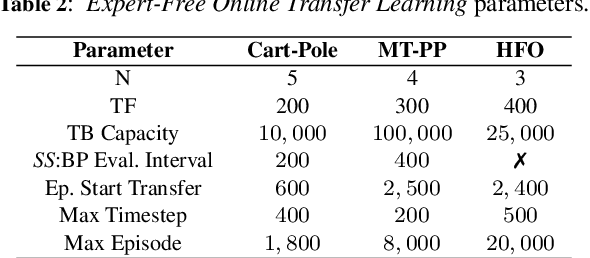
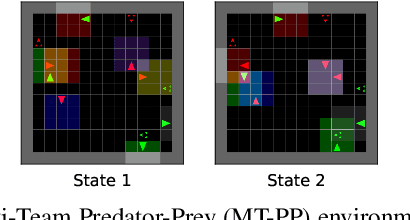
Abstract:Transfer learning in Reinforcement Learning (RL) has been widely studied to overcome training issues of Deep-RL, i.e., exploration cost, data availability and convergence time, by introducing a way to enhance training phase with external knowledge. Generally, knowledge is transferred from expert-agents to novices. While this fixes the issue for a novice agent, a good understanding of the task on expert agent is required for such transfer to be effective. As an alternative, in this paper we propose Expert-Free Online Transfer Learning (EF-OnTL), an algorithm that enables expert-free real-time dynamic transfer learning in multi-agent system. No dedicated expert exists, and transfer source agent and knowledge to be transferred are dynamically selected at each transfer step based on agents' performance and uncertainty. To improve uncertainty estimation, we also propose State Action Reward Next-State Random Network Distillation (sars-RND), an extension of RND that estimates uncertainty from RL agent-environment interaction. We demonstrate EF-OnTL effectiveness against a no-transfer scenario and advice-based baselines, with and without expert agents, in three benchmark tasks: Cart-Pole, a grid-based Multi-Team Predator-Prey (mt-pp) and Half Field Offense (HFO). Our results show that EF-OnTL achieve overall comparable performance when compared against advice-based baselines while not requiring any external input nor threshold tuning. EF-OnTL outperforms no-transfer with an improvement related to the complexity of the task addressed.
Deep W-Networks: Solving Multi-Objective Optimisation Problems With Deep Reinforcement Learning
Nov 09, 2022Abstract:In this paper, we build on advances introduced by the Deep Q-Networks (DQN) approach to extend the multi-objective tabular Reinforcement Learning (RL) algorithm W-learning to large state spaces. W-learning algorithm can naturally solve the competition between multiple single policies in multi-objective environments. However, the tabular version does not scale well to environments with large state spaces. To address this issue, we replace underlying Q-tables with DQN, and propose an addition of W-Networks, as a replacement for tabular weights (W) representations. We evaluate the resulting Deep W-Networks (DWN) approach in two widely-accepted multi-objective RL benchmarks: deep sea treasure and multi-objective mountain car. We show that DWN solves the competition between multiple policies while outperforming the baseline in the form of a DQN solution. Additionally, we demonstrate that the proposed algorithm can find the Pareto front in both tested environments.
Causal Counterfactuals for Improving the Robustness of Reinforcement Learning
Nov 02, 2022



Abstract:Reinforcement learning (RL) is applied in a wide variety of fields. RL enables agents to learn tasks autonomously by interacting with the environment. The more critical the tasks are, the higher the demand for the robustness of the RL systems. Causal RL combines RL and causal inference to make RL more robust. Causal RL agents use a causal representation to capture the invariant causal mechanisms that can be transferred from one task to another. Currently, there is limited research in Causal RL, and existing solutions are usually not complete or feasible for real-world applications. In this work, we propose CausalCF, the first complete Causal RL solution incorporating ideas from Causal Curiosity and CoPhy. Causal Curiosity provides an approach for using interventions, and CoPhy is modified to enable the RL agent to perform counterfactuals. We apply CausalCF to complex robotic tasks and show that it improves the RL agent's robustness using a realistic simulation environment called CausalWorld.
 Add to Chrome
Add to Chrome Add to Firefox
Add to Firefox Add to Edge
Add to Edge